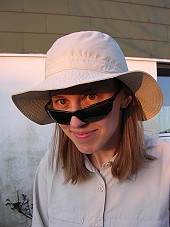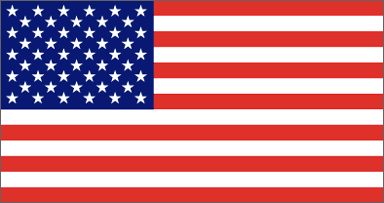
MARTINA'S WORLD TRIP
UNITED STATES: September 26 - December 3, 2004


(Übersetzungshilfe)
 |
MARTINA'S WORLD TRIP UNITED STATES: September 26 - December 3, 2004 |
|||||||
 |
||||||||
 |
Your Dictionary
(Übersetzungshilfe) |
|||||||
| Sunday, October 31st, 2004 - Happy Halloween! | |||||||||||
| It is 7:30 pm and I just opened the door to a half-sized magician, a ghost, a witch and to what I suppose was a boy disguised as the murderer from the Scream movies. Not only did he look scary enough in his black hooded cloak and the white death mask, no, the mask also had a special function: Upon the click of a hidden button, dark red blood was running over his face... Welcome to Halloween! I assume everyone knows Halloween as one of America’s most popular holidays that takes place every year on October 31st. Increasing globalisation, or shall I say “americanisation”, over the past years has brought the annual celebration of Halloween to most Western countries all over the world and many people, even in Europe, party today. But did you ever ask yourself what‘s it all about? I wanted to know: Why do we actually celebrate Halloween? And how did this particular custom originate? So I started to research... And guess what: The word “Halloween” has its origin in the Catholic Church – who would have thought that? It comes from a contracted corruption of ‘All Hallows Eve’. As you may know, November 1st is All Saints Day, a Catholic holiday in honour of the saints. Apparently, another term for it is ‘All Hollows Day’. Far before Christianity came up with a day to celebrate its saints, that is to say in the 5th century BC, the people in Celtic Ireland celebrated Mother Nature and October 31st was the day their summer ended. Back then, this day was celebrated as ‘Samhain’, the Celtic New Year. Legend says that on that day the disembodied spirits of all those who died throughout the preceding year would come back in search of living bodies to possess for the next year. It was believed to be their only hope for the afterlife. The Celts believed that all laws of space and time were suspended on this day, allowing the spirit world to intermingle with the living. Obviously, nobody was keen on being possessed by the spirit of the dead, so on the night of October 31st, villagers would extinguish the fires in their homes to make them cold and undesirable. Then they would dress up in all manner of ghoulish costumes and noisily parade around the neighbourhood, being as destructible as possible in order to frighten away the spirits looking for bodies to possess. Later, the Romans adopted the Celtic practices as their own. But in the first century AD, Samhain was assimilated into celebrations of some of the other Roman traditions that took place in October. As belief in spirit possession waned, the practice of disguising as goblins, ghosts, and witches turned more into a ceremonial ritual than a ‘necessity’. The custom of Halloween was brought to America in the 1840s by Irish immigrants fleeing their country’s potato famine. Over time, American Halloween has become what it is today: Once it gets dark on October 31st, kids dress up in scary costumes (the creepier the better), go from door to door in their neighbourhood to say “trick or treat” and receive candy. At first, I didn’t understand if “trick or treat” was a request or rather a threat and nobody could really explain what these famous words meant. So I looked it up, too: Apparently, the custom of trick-or-treating has its origin with a ninth-century European custom called ‘souling’. On November 2nd, which used to be celebrated as ‘All Souls Day’, early Christians would walk from village to village begging for what they called ‘soul cakes’. The more soul cakes (= square pieces of raisin bread) the beggars would receive, the more prayers they would promise to say on behalf of the dead relatives of the donors. (At the time, it was believed that the dead remained in some sort of ‘pre-hell’ for a certain time after death, and that prayer could accelerate a soul’s passage to heaven.) At the time, when American Halloween became a kids’ celebration, popular jokes (= “tricks”) children liked to play were tipping over outhouses (Plumpsklohäuschen umkippen!) and unhinging fence gates. So while trick-or-treating on Halloween, people could choose to give the kids a treat, rather than become a victim of their tricks... Last but not least, there is the thing about the pumpkin. Why do people carve mean faces into innocent pumpkins, light a candle inside and put them all over the place? Well, it looks like these “Jack-o-lanterns” come from Irish folklore. As the tale is told, a man named Jack, who was notorious as a drunkard and trickster, tricked Satan into climbing a tree. Jack then carved an image of a cross in the tree’s trunk, trapping the devil up the tree. Jack made a deal with the devil that, if he would never tempt him again, he would promise to let him down. According to the folk tale, after Jack died he was denied entrance to Heaven because of his evil ways, but he was also denied access to Hell because he had tricked the devil. Instead, the devil gave him a single ember to light his way through eternal darkness. The ember (glühende Kohle) was placed inside a hollowed-out turnip (Rübe) to keep it glowing longer. The Irish originally used turnips as their “Jack’s lanterns”. But when the immigrants came to America, they found that pumpkins were far more plentiful than turnips. So the Jack-o-lantern in America was a hollowed-out pumpkin, lit with an ember... Well, I don’t know what you think but I must say that I find it quite interesting to learn about customs like this! Of course, Aaron and I also prepared a pumpkin and put it on the front porch tonight, so the kids can find their way for trick-or-treating and I will make sure they get some candy – I really wouldn’t like them to tip over the outhouse... ;o) Happy Halloween Everybody! |
|||||||||||